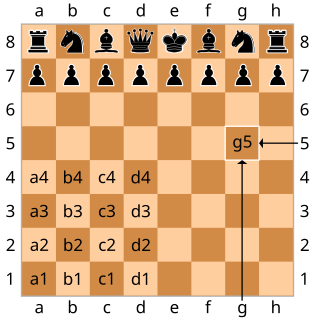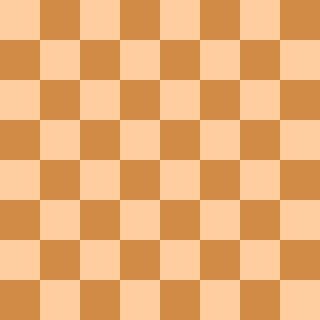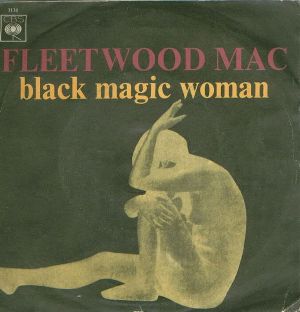Related Research Articles
The decibel is a unit of measurement used to express the ratio of one value of a power or field quantity to another, on a logarithmic scale, the logarithmic quantity being called the power level or field level, respectively. It can be used to express a change in value or an absolute value. In the latter case, it expresses the ratio of a value to a fixed reference value; when used in this way, a suffix that indicates the reference value is often appended to the decibel symbol. For example, if the reference value is 1 volt, then the suffix is "V", and if the reference value is one milliwatt, then the suffix is "m".

In music, a note is a symbol denoting a musical sound. In English usage a note is also the sound itself.

Algebraic notation is a method for recording and describing the moves in a game of chess. It is based on a system of coordinates to uniquely identify each square on the chessboard. It is now standard among all chess organizations and most books, magazines, and newspapers. In English-speaking countries, the parallel method of descriptive notation was generally used in chess publications until about 1980. Some older players still use descriptive notation, but it is no longer recognized by FIDE.
In computer science, extended Backus–Naur form (EBNF) is a family of metasyntax notations, any of which can be used to express a context-free grammar. EBNF is used to make a formal description of a formal language such as a computer programming language. They are extensions of the basic Backus–Naur form (BNF) metasyntax notation.

LilyPond is a computer program and file format for music engraving. One of LilyPond's major goals is to produce scores that are engraved with traditional layout rules, reflecting the era when scores were engraved by hand.

Finale is the flagship program of a series of proprietary music notation software developed and released by MakeMusic for the Microsoft Windows and macOS operating systems. First released in 1988, version 26 was released in 2018. Finale has been regarded as one of the industry standards for music notation software.
Portable Game Notation (PGN) is a plain text computer-processible format for recording chess games, supported by many chess programs.

In music, letter notation is a system of representing a set of pitches, for example, the notes of a scale, by letters. For the complete Western diatonic scale, for example, these would be the letters A-G, possibly with a trailing symbol to indicate a half-step raise--(a sharp♯), or a half-step lowering. This is the most common way of specifying a note in speech or in written text in English or German. In some European countries H is used instead of B, and B is used instead of B♭.

A scorewriter, or music notation program is software used with a computer for creating, editing and printing sheet music. A scorewriter is to music notation what a word processor is to text, in that they both allow fast corrections (undo), flexible editing, easy sharing of electronic documents, and clean, uniform layout. In addition, most scorewriters, especially those from the 2000s, are able to record notes played on a MIDI keyboard, and play music back via MIDI or virtual instruments. Playback is especially useful for novice composers or music students or when no musicians are readily available or affordable.

Braille music is a Braille code that allows music to be notated using Braille cells so music can be read by visually impaired musicians. The Braille music system was originally developed by Louis Braille.
Chess notations are various systems that have developed to record either the moves made in a game of chess or the position of pieces on a chessboard. The earliest systems of notation used lengthy narratives to describe each move; these gradually evolved into terser notation systems. Currently algebraic chess notation is the accepted standard and is widely used. Algebraic notation has several variations. Descriptive chess notation was used in English- and Spanish-language literature until the late 20th century, but is now obsolete. There are some special systems for international correspondence chess. Portable Game Notation is used when working with computer chess programs. Systems also exist for transmission using Morse code over telegraph or radio.
In music, a minor seventh chord is any seventh chord in which the third is a minor third above the root. Most typically, minor seventh chord refers to a chord in which the third is a minor third above the root and the seventh is a minor seventh above the root. For example, the minor/minor seventh chord built on C, commonly written as C–7, has pitches C–E♭–G–B♭:

In music, a barre chord is a type of chord on a guitar or other stringed instrument, that the musician plays by using one or more fingers to press down multiple strings across a single fret of the fingerboard.

Larsen's Opening is a chess opening starting with the move:

The adenosine A1 receptor is one member of the adenosine receptor group of G protein-coupled receptors with adenosine as endogenous ligand.

"Black Magic Woman" is a song written by British musician Peter Green, which first appeared as a Fleetwood Mac single in various countries in 1968, subsequently appearing on the 1969 Fleetwood Mac compilation albums English Rose (US) and The Pious Bird of Good Omen (UK), as well as Vintage Years.

Impro-Visor is an educational tool for creating and playing a lead sheet, with a particular orientation toward representing jazz solos.
In music, harmonization is the chordal accompaniment to a line or melody: "Using chords and melodies together, making harmony by stacking scale tones as triads".
GUIDO Music Notation is a computer music notation format designed to logically represent all aspects of music in a manner that is both computer-readable and easily readable by human beings. It was named after Guido of Arezzo, who pioneered today's conventional musical notation 1,000 years ago.
This is a comparison of music notation programs.
References
- "mustech.net".
This is a great little program that can easily be translated into the classroom.
- "Music Notation Software". Archived from the original on 2007-12-11. Retrieved 2007-12-10. by Gordon J. Callon